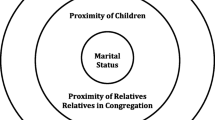Abstract
This study examined the role of congregational support as a mechanism by which religious involvement may slow the decline of functional ability during late life. Disability was tracked longitudinally over a 4-year period in a national sample of 805 Black and White older adults from the religion, aging, and health survey. Individuals with more extensive disability reported receiving greater amounts of tangible support from their congregations. However, receiving higher levels of tangible support was also associated with a slower trajectory of increase in disability over time. The relationship between congregational support and disability did not differ significantly between Blacks and Whites. Results support the hypothesis that social support networks based in the religious group are responsible for some of the association between religious involvement and reduced risk of late life disability.
Similar content being viewed by others
References
Cassel, J. (1964). Social science theory as a source of hypotheses in epidemiological research. American Journal of Public Health, 54, 1482–1488. doi:10.2105/AJPH.54.9.1482
Christensen, K., McGue, M., Petersen, I., Jeune, B., & Vaupel, J. W. (2008). Exceptional longevity does not result in excessive levels of disability. Proceedings of the National Academy of Sciences, 105, 13274–13279. doi:10.1073/pnas.0804931105
Curran, P. J., Obeidat, K., & Losardo, D. (2010). Twelve frequently asked questions about growth curve modeling. Journal of Cognition and Development, 11, 121–136. doi:10.1080/15248371003699969
Fitchett, G., Rybarczyk, B. D., DeMarco, G. A., & Nicholas, J. J. (1999). The role of religion in medical rehabilitation outcomes: A longitudinal study. Rehabilitation Psychology, 44, 333–353. doi:10.1037/0090-5550.44.4.333
Hayward, R. D., & Elliott, M. (2011). Subjective and objective fit in religious congregations: Implications for well-being. Group Processes and Intergroup Relations, 14, 127–139. doi:10.1177/1368430210370041
Idler, E. L. (1987). Religious involvement and the health of the elderly: Some hypotheses and an initial test. Social Forces, 66, 226–238. doi:10.2307/2578909
Idler, E. L., & Kasl, S. V. (1992). Religion, disability, depression, and the timing of death. American Journal of Sociology, 97, 1052–1079. doi:10.1086/229861
Idler, E. L., & Kasl, S. V. (1997). Religion among disabled and nondisabled persons II: Attendance at religious services as a predictor of the course of disability. The Journals of Gerontology Series B: Psychological Sciences and Social Sciences, 52B, S306–S316. doi:10.1093/geronb/52B.6.S306
Koenig, H. G., George, L. K., & Titus, P. (2004). Religion, spirituality, and health in medically ill hospitalized older patients. Journal of the American Geriatrics Society, 52, 554–562. doi:10.1111/j.1532-5415.2004.52161.x
Krause, N. (2002a). Church-based social support and health in old age. The Journals of Gerontology Series B: Psychological Sciences and Social Sciences, 57, S332–S347. doi:10.1093/geronb/57.6.S332
Krause, N. (2002b). Exploring race differences in a comprehensive battery of church-based social support measures. Review of Religious Research, 44, 126–149. doi:10.2307/3512512
Krause, N. (2004). Common facets of religion, unique facets of religion, and life satisfaction among older African Americans. The Journals of Gerontology: Series B: Pschological Sciences and Social Sciences, 59B, S109–S117. doi:10.1093/geronb/59.2.S109
Krause, N. (2006). Exploring the stress-buffering effects of church-based and secular social support on self-rated health in late life. The Journals of Gerontology Series B: Psychological Sciences and Social Sciences, 61, S35–S43. doi:10.1093/geronb/61.1.S35
Krause, N. (2008). Krause, N. (2008). Aging in the church: How social relationships affect health. West Conshohocken, PA: Templeton Foundation Press.. West Conshohocken, PA: Templeton Foundation Press.
Levine, R. S., Foster, J. E., Fullilove, R. E., Fullilove, M. T., Briggs, N. C., Hull, P. C., Husaini, B. A., et al. (2001). Black-White inequalities in mortality and life expectancy, 1933-1999: Implications for Healthy People 2010. Public Health Reports (1974–), 116, 474–483. doi:10.1093/phr/116.5.474
Manton, K. G., Gu, X., & Lamb, V. L. (2006). Change in chronic disability from 1982 to 2004/2005 as measured by long-term changes in function and health in the U.S. elderly population. Proceedings of the National Academy of Sciences, 103, 18374–18379. doi:10.1073/pnas.0608483103
Pargament, K. I., Smith, B. W., Koenig, H. G., & Perez, L. (1998). Patterns of positive and negative religious coping with major life stressors. Journal for the Scientific Study of Religion, 37, 710–724. doi:10.2307/1388152
Powell, L. H., Shahabi, L., & Thoresen, C. E. (2003). Religion and spirituality: Linkages to physical health. American Psychologist, 58, 36–52. doi:10.1037/0003-066x.58.1.36
Taylor, M. G. (2008). Timing, accumulation, and the Black/White disability gap in later life. Research on Aging, 30, 226–250. doi:10.1177/0164027507311838
Taylor, R. J., Chatters, L. M., & Levin, J. S. (2004). Religion in the lives of African Americans: social, psychological, and health perspectives. Thousand Oaks, CA: Sage Publications.
West, B. T., Welch, K. B., & Galecki, A. T. (2007). Linear mixed models: A practical guide using statistical software. Boca Raton, FL: Chapman & Hall/CRC.
Williams, D. R. (2005). The health of U.S. racial and ethnic populations. The Journals of Gerontology Series B: Psychological Sciences and Social Sciences, 60, S53–S62. doi:10.1093/geronb/60.Special_Issue_2.S53
Acknowledgments
This work was supported by National Institute on Aging at the National Institutes of Health (grant number R01 AG014749); and the John Templeton Foundation.
Author information
Authors and Affiliations
Corresponding author
Rights and permissions
About this article
Cite this article
Hayward, R.D., Krause, N. Trajectories of disability in older adulthood and social support from a religious congregation: a growth curve analysis. J Behav Med 36, 354–360 (2013). https://doi.org/10.1007/s10865-012-9430-4
Received:
Accepted:
Published:
Issue Date:
DOI: https://doi.org/10.1007/s10865-012-9430-4




